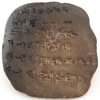Babylonian Maths
4000 years ago, children in school were learning maths just as they do now. But what maths did they learn and how did they learn it? In this resource pack, Dr Eleanor Robson, shows us how we can find out about an ancient civilisation through the objects they left behind.
She demonstrates clay tablets on which Babylonian children worked at their multiplication tables - in base 60! Through the video clips and follow-up resources, we can find out how they did arithmetic and how they learnt their tables. Eleanor also demonstrates the difference between how we generally draw a triangle now and then, and how the Babylonian style of writing - cuneiform - relates to their triangles.
********
The resources in this pack complement the video clips, providing activities designed to help students understand the similarities and differences between maths then and now. Answers and additional notes are also provided.
This resource pack is aimed at children aged 10-12. We hope that it will be girl-friendly, without being boy-unfriendly, and that it could be used as a means of bridging the transition between primary school and secondary school, perhaps forming part of a Transition Day, or a topic which could be started in the primary school then completed in the secondary school.
Any of these resources can be used alone - although students may find it easier to understand them if they have seen the preceding video clip(s).
- Download all video clips (zip file, 53MB)
- Download all pdf files
| Type of Resource | Resource Name | Difficulty | Notes |
| Teacher notes and worksheet answers | Start here! | ||
| Babylonian Mathematics | Additional notes and drawings from tablets for anyone who wants to know a bit more. | ||
| Eleanor Robson: Maths Archaeologist | * | Video clip 1: Introductory video clip (1 min 47 secs) | |
| Archaeology and your maths classroom | * | Video clip 2 (2 mins 36 secs) | |
| Activity | * |
If there was a fire or an earthquake tonight and your classroom was destroyed, what would a maths archaeologist find? What might s/he think about your maths class? |
|
| A Babylonian House | * | Video clip 3 (3 mins 20 secs) | |
| Babylonian Houses | ** | Worksheet - do a scale drawing of a Babylonian house or see how the area of a Babylonian house compares with a modern one by finding rectangular areas. You will need to work in cubits to start with! | |
| Clay Tablets | Video clip 4 (2 mins 56 secs) | ||
| Make Your Own Clay Tablets | * | Presentation - make your own Babylonian tablet, complete with Babylonian numbers. | |
| Babylonian Triangles | * | Video clip 5 (2 mins 19 secs) | |
| Triangles and Squares | * | Worksheet - area of squares and triangles (counting squares is fine for this), symmetry, investigation | |
| Babylonian Numbers: 1 to 9 | * | Video clip 6 (2 mins 36 secs) | |
| Babylonian Numbers: tens and units | * | Video clip 7 (1 min 44 secs) | |
| Babylonian Numbers: base 60 | ** | Video clip 8 (1 min 59 secs) | |
| Numbers in base 60 | ** | Presentation - working with numbers in base 60 | |
| Numbers in base 60 | ** | Worksheet - to follow-up the presentation | |
| Fractions in base 60 | *** | Worksheet - this follows on from Numbers in base 60 | |
| Learning to multiply - the Babylonian way | ** | Video clip 9 (3 mins 16 secs) | |
| Multiplication - the Babylonian way | ** | Worksheet - follow-up worksheet | |
| Division - the Babylonian way | *** | Worksheet - students will need to know about multiplication and fractions in base 60 | |
| Deciphering a Babylonian Tablet | *** | Worksheet - drawings of multiplication problems, one involving simple fractions, on two Babylonian tables to decipher. Did the Babylonian scribes get them right? |



